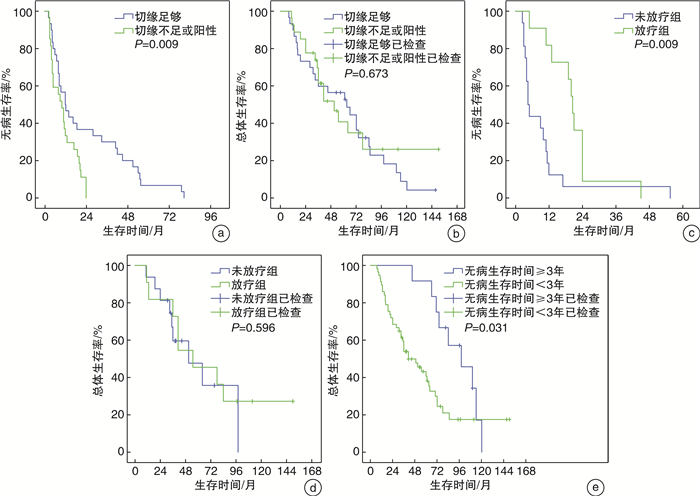Analysis of correlation factors and prognosis of local recurrence of laryngeal squamous cell carcinoma
-
摘要: 目的 探讨喉鳞状细胞癌局部复发的影响因素及预后。方法 回顾性分析69例局部复发性喉鳞状细胞癌患者的临床资料。生存曲线绘制采用Kaplan-Meier法,生存率的比较采用卡方检验、log rank检验,采用Cox风险回归模型进行多因素生存分析。结果 局部复发性喉鳞状细胞癌患者3年无病生存率、总体生存率分别为17.4%、63.8%;5年无病生存率、总体生存率分别为4.3%、40.6%。甲状软骨板是否侵犯与患者预后显著相关,鳞状细胞癌分化程度是影响患者预后的独立因素,甲状软骨板未侵犯、高分化鳞状细胞癌患者预后更佳(P < 0.05)。结论 病理中、低分化、伴有甲状软骨板侵犯、切缘阳性或不足的喉鳞状细胞癌患者易出现局部复发,经挽救性手术治疗预后仍较差,对该类患者应重视综合治疗及更密切随访。Abstract: Objective To explore the correlation factors and prognosis of local recurrence of laryngeal squamous cell carcinoma.Method The clinical data of 69 patients with local recurrence of laryngeal squamous cell carcinoma were analyzed retrospectively. The survival curve was analyzed by Kaplan-Meier method, and the survival rate was compared by chi-square test and log rank test, Cox risk regression model was used to analyze multivariate survival.Result Patients with local recurrence of laryngeal cancer had DFS and OS at 3 years of 17.4% and 63.8%, at 5 years of 4.3% and 40.6%, respectively. The invasion of the thyroid cartilage plate is significantly related to the prognosis of the patient, and the degree of squamous cell carcinoma differentiation is an independent factor influencing the prognosis, patients with non-invasive thyroid cartilage plate and high differentiated squamous cell carcinoma have better prognosis.Conclusion Local recurrence of laryngeal carcinoma is common among patients with moderately or poorly differentiated squamous cell carcinoma, invasion of the thyroid cartilage plate, and positive or insufficient resection margins. And the prognosis of above patients is still poor after receiving salvage surgery; comprehensive treatment and closer follow-up should be paid to these patients.
-
Key words:
- laryngeal neoplasms /
- squamous cell carcinoma /
- local recurrence /
- prognosis
-

-
表 1 69例局部复发性喉癌患者预后影响因素的单因素分析
临床病理 例数 3年无病生存率/% P值 3年总体生存率/% P值 5年无病生存率/% P值 5年总体生存率/% P值 年龄 0.803 0.907 0.857 0.436 < 60岁 38 18.4 63.2 2.6 44.7 ≥60岁 31 16.1 64.5 6.4 35.5 分型 0.803 0.535 0.314 0.484 声门型 38 18.4 60.5 7.9 36.8 声门上型 31 16.1 67.7 0 45.2 有无颈部淋巴转移 0.236 0.575 1.000 0.089 无 57 14.0 61.4 3.5 35.1 有 12 33.3 75.0 8.3 66.7 临床分期 0.698 0.261 0.857 0.092 Ⅰ、Ⅱ期 31 19.4 71.0 6.5 51.6 Ⅲ、Ⅳ期 38 15.8 57.9 2.6 31.6 T分期 0.269 0.127 1.000 0.008 T1~2 36 22.2 72.2 5.6 55.6 T3~4 33 12.1 54.5 3.0 24.2 分化程度 < 0.001 0.001 0.008 < 0.001 高分化 15 66.7 100.0 20.0 100.0 中、低分化 54 3.7 53.7 0 24.1 是否侵犯甲状软骨板 0.811 0.013 1.000 < 0.001 否 41 19.5 75.6 4.9 58.5 是 28 14.3 46.4 3.6 7.1 -
[1] Chen W, Zheng R, Baade PD, et al. Cancer statistics in China, 2015[J]. CA Cancer J Clin, 2016, 66(2): 115-132. doi: 10.3322/caac.21338
[2] Goodwin WJ Jr. Salvage surgery for patients with recurrent squamous cell carcinoma of the upper aerodigestive tract: when do the ends justify the means?[J]. Laryngoscope, 2000, 110(3 Pt 2 Suppl 93): 1-18.
[3] Jones TM, De M, Foran B, et al. Laryngeal cancer: United Kingdom National Multidisciplinary guidelines[J]. J Laryngol Otol, 2016, 130(S2): S75-S82. doi: 10.1017/S0022215116000487
[4] Forastiere AA, Ismaila N, Wolf GT. Use of Larynx-Preservation Strategies in the Treatment of Laryngeal Cancer: American Society of Clinical Oncology Clinical Practice Guideline Update Summary[J]. J Oncol Pract, 2018, 14(2): 123-128. doi: 10.1200/JOP.2017.027912
[5] 乐慧君, 陈思宇, 李芸, 等. 喉癌诊疗策略及进展[J]. 临床耳鼻咽喉头颈外科杂志, 2019, 33(11): 1017-1021. https://www.cnki.com.cn/Article/CJFDTOTAL-LCEH201911003.htm
[6] Johansen LV, Grau C, Overgaard J. Laryngeal carcinoma——multivariate analysis of prognostic factors in 1252 consecutive patients treated with primary radiotherapy[J]. Acta Oncol, 2003, 42(7): 771-778. doi: 10.1080/02841860310017595
[7] 伊海金, 张宝泉, 王春红, 等. 喉癌治疗后复发的临床因素分析及治疗[J]. 山东大学耳鼻喉眼学报, 2011, 25(3): 18-21. https://www.cnki.com.cn/Article/CJFDTOTAL-SDYU201103007.htm
[8] Birkeland AC, Beesley L, Bellile E, et al. Predictors of survival after total laryngectomy for recurrent/persistent laryngeal squamous cell carcinoma[J]. Head Neck, 2017, 39(12): 2512-2518. doi: 10.1002/hed.24918
[9] Canis M, Ihler F, Martin A, et al. Transoral laser microsurgery for T1a glottic cancer: review of 404 cases[J]. Head Neck, 2015, 37(6): 889-895. doi: 10.1002/hed.23688
[10] Silverman DA, Puram SV, Rocco JW, et al. Salvage laryngectomy following organ-preservation therapy-An evidence-based review[J]. Oral Oncol, 2019, 88: 137-144. doi: 10.1016/j.oraloncology.2018.11.022
[11] Fowler BZ, Muller S, Chen AY, et al. Factors influencing long-term survival following salvage total laryngectomy after initial radiotherapy or conservative surgery[J]. Head Neck, 2006, 28(2): 99-106. doi: 10.1002/hed.20297
[12] Yiotakis J, Stavroulaki P, Nikolopoulos T, et al. Partial laryngectomy after irradiation failure[J]. Otolaryngol Head Neck Surg, 2003, 128(2): 200-209. doi: 10.1067/mhn.2003.63
-





 下载:
下载: